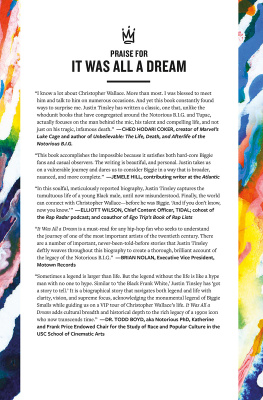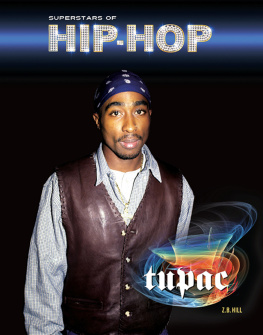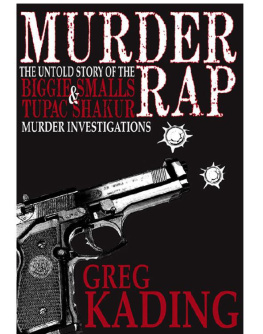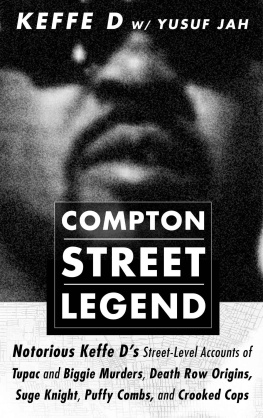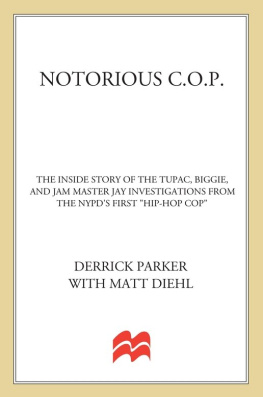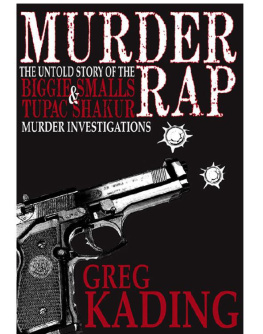


First published in 2013 by Voyageur Press, an imprint of MBI Publishing Company, 400 First Avenue North, Suite 400, Minneapolis, MN 55401 USA
2013 Voyageur Press
All rights reserved. With the exception of quoting brief passages for the purposes of review, no part of this publication may be reproduced without prior written permission from the Publisher.
The information in this book is true and complete to the best of our knowledge. All recommendations are made without any guarantee on the part of the author or Publisher, who also disclaims any liability incurred in connection with the use of this data or specific details.
This publication has not been prepared, approved, or licensed by the estates of Christopher Wallace or Tupac Shakur, nor of the record companies that have released their work. We recognize, further, that some words, model names, and designations mentioned herein are the property of the trademark holder. We use them for identification purposes only. This is not an official publication.
Voyageur Press titles are also available at discounts in bulk quantity for industrial or sales-promotional use. For details write to Special Sales Manager at MBI Publishing Company, 400 First Avenue North, Suite 400, Minneapolis, MN 55401 USA.
To find out more about our books, visit us online at www.voyageurpress.com.
Digital Edition: 978-1-61058-793-8
Softcover Edition: 978-0-7603-4367-8
Library of Congress Cataloging-in-Publication Data
McGarvey, Evan, 1984
2pac v. Biggie : an illustrated history of raps greatest battle / Evan McGarvey and Jeff Weiss.
p. cm.
Includes bibliographical references.
ISBN 978-0-7603-4367-8 (softcover)
1. Shakur, Tupac, 1971-1996. 2. Notorious B.I.G., 1972-1997. 3. Rap musicians--United States--Biography. 4. Rap (Music)--History and criticism. I. Weiss, Jeff, 1981- II. Title. III. Title: Tupac v. Biggie. IV. Title: 2pac versus Biggie. V. Title: Tupac versus Biggie.
ML420.S529M34 2013
782.4216490922--dc23
[B]
2012040556
Cover: (left) Scott Gries / Getty Images, (right) Ferdaus Shamim / WireImage / Getty Images Back flap: Pac and Big, by Reuben Cheatem. Courtesy of the artist. Frontis: Tupac Shakur (left) and TheNotorious B.I.G. (right), by Jordan Zehner. Stencil on newspaper. Courtesy of the artist; : Legends Together, by Matt Burke. Oil painting, 2009. Features The Notorious B.I.G., 2Pac, Eminem, Dr. Dre, T.I., Lil Wayne, and Kanye West. Courtesy of the artist
Editor: Grace Labatt
Design Manager: James Kegley
Layout: Kim Winscher
Page designer: Sandra Salamony
10 9 8 7 6 5 4 3 2 1

CONTENTS

Less than two decades after the deaths of Tupac Shakur and Christopher Wallace, it has become impossible to speak one name without hearing the other. 2Pac and Biggie. Biggie and 2Pac. You see a poster of one and think of an image of the other. You get to know a friend, a fellow rap fan, and you ask whom they prefer. It feels natural when a partys soundtrack moves from the fizzy, delirious California Love to the elemental bass of Hypnotize. Biggie and 2Pac. 2Pac and Biggie.
They died six months apart. Tupac was murdered in September of 1996, Biggie in March of 1997. Since then, their complicated bond has ossified in our social memory. The ampersand, the ellipsis, the vs.whatever link now appears in our mind when we think about 2Pac and Biggie is due for complication. This book is an attempt to provide listeners, new and old, with fresh angles for appreciating The Notorious B.I.G. and 2Pac. (Throughout the book, Tupac will refer to the person, 2Pachis rap nameto the artist.)
They were dynamic men, driven self-inventors and iconoclasts. Born a chubby, doted-upon only child, Biggie became a dapper hip-hop don with a visceral, visual imagination and a voice like cavalry riding across marble. 2Pac was a reedy art-school student who transformed himself into the most famous poet-provocateur-outlaw this side of Rimbaud. Both served as the faces of industry-shaking record labels. Both ushered rap into the era of pyrotechnic music videos, pop dominance, and global audiences.
But why Biggie and 2Pac? While subversive, neither rapper made the most transgressive songs of the era. Each had massive commercial success, but neither cut a particularly pop-friendly figure. However, as different as they were in appearance, biography, and temperament, they shared one magnificent quality: the ability to synthesize an assortment of artistic virtues into a singular, irresistible presentation.
Where Biggie became a master of genre and perspective and detail, 2Pac created rhetoric that could champion sprawling spirituality and triumphant cooperation in one moment and fierce self-preservation and fatalism in the next. They did not merely emphasize their strengths as MCs and rappers and performers; they each created a verbal universe. For this kind of artistic fulfillment to happen once in a generation is an event. For it to happen to two artists, and for the artists not only to know one another but also to find their work in dialogue and their lives woven together with threads of camaraderie, betrayal, and death, is monumental.
The books about the two are many. In particular, the time from Tupacs criminal trial in 1994 until Biggies murder in 1997 has been examined, researched, and argued endlessly. But this book aims to bring fresh perspective to the irreducible core of 2Pac and Biggies shared legacy: the music. After all, musicseminal albums, unforgettable singles, and apocryphal early recordingsis what they have left behind. We examine Biggie and 2Pac individually, talk about each stage in their lives and how each rendered that chapter or theme into music. Their subjects were the timeless subjects of American pop music: childhood, adolescence, love, sex, getting rich, staying rich, family, friendship, hate, work, play, choice, fate. And the lyrical routes each took across this terrain reflect their identities as artists. The instances of consonance thrill: a creeping paranoia infuses both 2Pacs All Eyez On Me and Biggies My Downfall. The instances of separation instruct. Compare the two approaches to biography in 2Pacs sympathetic, humane Dear Mama and in Biggies clinical, systematic Skys The Limit. Their lyrical approaches, song structures, storytelling habits, vocabularies, cadences, engagements with big human themesthese are what make Biggie and 2Pac so endlessly fascinating, so rewarding to hear individually and in contrast.
We are fascinated by Biggie and 2Pac because the cultural moment in which we live is part of their legacy. Hip-hop has become pop. The art of rap has influenced singers, songwriters, and producers in every genre of popular music. A hundred would-be rappers use manufactured beef to try to drum up record sales. The line between performer and performance was always permeable and useful, but Biggie and 2Pac made it threatening. Academia has taken up both men as subjects of study. 2Pacs face appears on murals in ghettos, favelas, and shantytowns around the world. Biggies phrases nestle in sitcom scripts and news teleprompters. A decade after Biggie documented the bloodless exchange of human dreams for crude capital in his album
Next page

